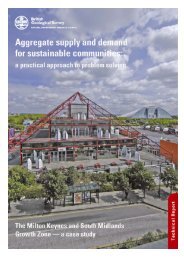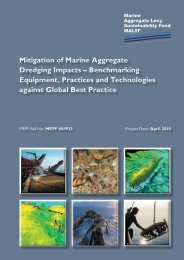creating environmental improvements through biodiversity
creating environmental improvements through biodiversity
creating environmental improvements through biodiversity
You also want an ePaper? Increase the reach of your titles
YUMPU automatically turns print PDFs into web optimized ePapers that Google loves.
organisations and funding bodies on this<br />
Statement that tourism will be promoted as part of a wider regional tourism resource<br />
Discussion of a visitor centre and statement that it would be constructed after a widely publicised<br />
architectural competition<br />
Description of current proposals for a linked facility with North Notts College, with many shared facilities<br />
including the car park and a café/restaurant area<br />
Statement that buildings will be of sustainable design and heated with locally-sourced energy (wood chip or<br />
geothermal)<br />
Statement that development is expected over five years with the phased acquisition of areas and<br />
development of facilities, which will link with the withdrawal of Tarmac from many areas of the site, and more<br />
conservation focused management of areas within and outside the SSSI boundaries<br />
Statement that conditions for this type of project may well be present in most areas of the UK, providing<br />
similar opportunities to maximise social and economic benefit <strong>through</strong> <strong>environmental</strong> conservation.<br />
Table of notable species recorded at the site<br />
Impacts (Actual):<br />
The document mainly summarises previous reports on the project, but adds some detail on logistical aspects<br />
and an updated (Sep 04) state of affairs. It is a useful report for wide circulation as it outlines important<br />
aspects of the project without entering into great detail. In itself it does not include a research aspect.<br />
Impacts (Potential):<br />
The report could help to gain support for the project and raise interest among local businesses and<br />
communities, if disseminated appropriately.<br />
Potential Expansion:<br />
The Idle Valley Project has great potential for expansion, and should provide a good example of nature<br />
conservation assisting local regeneration – and vice versa. A series of bulletins such as this could provide up<br />
to date information to local communities and help to maintain a high local profile for the project. This role<br />
may be filled to some extent already, but on a less detailed or technical scale, by the ‘Idle Valley newsletter’.<br />
Dissemination:<br />
While it was not clear how widely this report was disseminated, a newsletter was produced for wide<br />
circulation.<br />
Sustainable Aggregates Creating Environmental Improvements <strong>through</strong> Biodiversity<br />
MAXIMISING THE HABITAT VALUE OF NON-OPERATIONAL AND<br />
RESTORED LAND AROUND MINERALS EXTRACTION SITES (MIRO MIST,<br />
FWAG)<br />
Barney Parker (Derbyshire FWAG), Chloe Palmer (FWAG Midlands Region), Jim Egan (Nottinghamshire<br />
FWAG). March 2004<br />
(Main responses to a MIRO questionnaire included)<br />
Project Type: Pilot, including ecological survey<br />
Site: East Midlands – Hope Shale &Limestone Quarry, Whitwell Quarry<br />
Project Aim:<br />
To evaluate the scope to use non-operational and restored land around (within the boundaries of) mineral<br />
extraction sites as a means of mitigating for ecological and other impacts<br />
(MIRO questionnaire: To highlight how the value of this land can be maximised <strong>through</strong> appropriate on-going<br />
management, enhancement and habitat creation)<br />
75

















